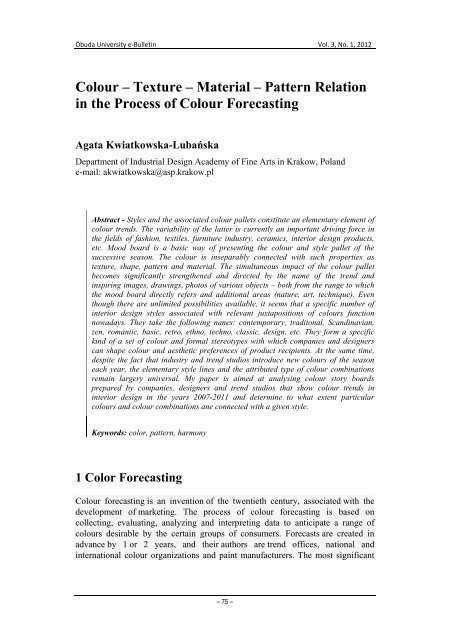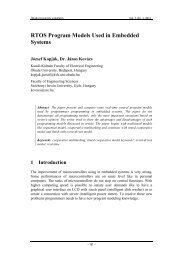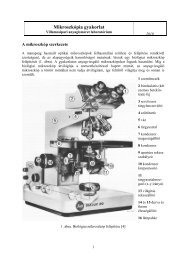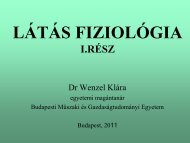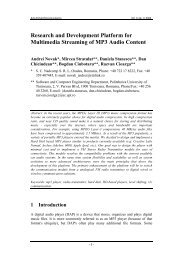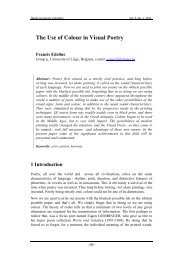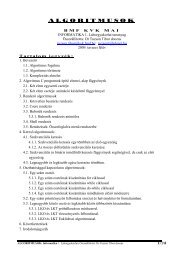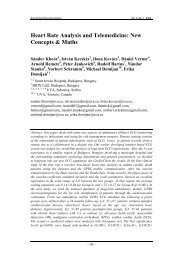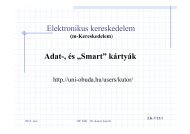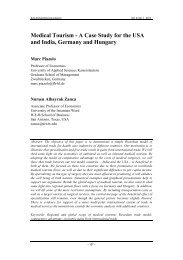Colour – Texture – Material – Pattern Relation in the Process of ...
Colour – Texture – Material – Pattern Relation in the Process of ...
Colour – Texture – Material – Pattern Relation in the Process of ...
Create successful ePaper yourself
Turn your PDF publications into a flip-book with our unique Google optimized e-Paper software.
Óbuda University e‐Bullet<strong>in</strong> Vol. 3, No. 1, 2012<br />
<strong>Colour</strong> <strong>–</strong> <strong>Texture</strong> <strong>–</strong> <strong>Material</strong> <strong>–</strong> <strong>Pattern</strong> <strong>Relation</strong><br />
<strong>in</strong> <strong>the</strong> <strong>Process</strong> <strong>of</strong> <strong>Colour</strong> Forecast<strong>in</strong>g<br />
Agata Kwiatkowska-Lubańska<br />
Department <strong>of</strong> Industrial Design Academy <strong>of</strong> F<strong>in</strong>e Arts <strong>in</strong> Krakow, Poland<br />
e-mail: akwiatkowska@asp.krakow.pl<br />
Abstract - Styles and <strong>the</strong> associated colour pallets constitute an elementary element <strong>of</strong><br />
colour trends. The variability <strong>of</strong> <strong>the</strong> latter is currently an important driv<strong>in</strong>g force <strong>in</strong><br />
<strong>the</strong> fields <strong>of</strong> fashion, textiles, furniture <strong>in</strong>dustry, ceramics, <strong>in</strong>terior design products,<br />
etc. Mood board is a basic way <strong>of</strong> present<strong>in</strong>g <strong>the</strong> colour and style pallet <strong>of</strong> <strong>the</strong><br />
successive season. The colour is <strong>in</strong>separably connected with such properties as<br />
texture, shape, pattern and material. The simultaneous impact <strong>of</strong> <strong>the</strong> colour pallet<br />
becomes significantly streng<strong>the</strong>ned and directed by <strong>the</strong> name <strong>of</strong> <strong>the</strong> trend and<br />
<strong>in</strong>spir<strong>in</strong>g images, draw<strong>in</strong>gs, photos <strong>of</strong> various objects <strong>–</strong> both from <strong>the</strong> range to which<br />
<strong>the</strong> mood board directly refers and additional areas (nature, art, technique). Even<br />
though <strong>the</strong>re are unlimited possibilities available, it seems that a specific number <strong>of</strong><br />
<strong>in</strong>terior design styles associated with relevant juxtapositions <strong>of</strong> colours function<br />
nowadays. They take <strong>the</strong> follow<strong>in</strong>g nanes: contemporary, traditonal, Scand<strong>in</strong>avian,<br />
zen, romantic, basic, retro, ethno, techno, classic, design, etc. They form a specific<br />
k<strong>in</strong>d <strong>of</strong> a set <strong>of</strong> colour and formal stereotypes with which companies and designers<br />
can shape colour and aes<strong>the</strong>tic preferences <strong>of</strong> product recipients. At <strong>the</strong> same time,<br />
despite <strong>the</strong> fact that <strong>in</strong>dustry and trend studios <strong>in</strong>troduce new colours <strong>of</strong> <strong>the</strong> season<br />
each year, <strong>the</strong> elementary style l<strong>in</strong>es and <strong>the</strong> attributed type <strong>of</strong> colour comb<strong>in</strong>ations<br />
rema<strong>in</strong> largery universal. My paper is aimed at analys<strong>in</strong>g colour story boards<br />
prepared by companies, designers and trend studios that show colour trends <strong>in</strong><br />
<strong>in</strong>terior design <strong>in</strong> <strong>the</strong> years 2007-2011 and determ<strong>in</strong>e to what extent particular<br />
colours and colour comb<strong>in</strong>ations ane connected with a given style.<br />
Keywords: color, pattern, harmony<br />
1 Color Forecast<strong>in</strong>g<br />
<strong>Colour</strong> forecast<strong>in</strong>g is an <strong>in</strong>vention <strong>of</strong> <strong>the</strong> twentieth century, associated with <strong>the</strong><br />
development <strong>of</strong> market<strong>in</strong>g. The process <strong>of</strong> colour forecast<strong>in</strong>g is based on<br />
collect<strong>in</strong>g, evaluat<strong>in</strong>g, analyz<strong>in</strong>g and <strong>in</strong>terpret<strong>in</strong>g data to anticipate a range <strong>of</strong><br />
colours desirable by <strong>the</strong> certa<strong>in</strong> groups <strong>of</strong> consumers. Forecasts are created <strong>in</strong><br />
advance by 1 or 2 years, and <strong>the</strong>ir authors are trend <strong>of</strong>fices, national and<br />
<strong>in</strong>ternational colour organizations and pa<strong>in</strong>t manufacturers. The most significant<br />
<strong>–</strong> 75 <strong>–</strong>
A. Kwiatkowska‐Lubańska <strong>Colour</strong> <strong>–</strong> texture <strong>–</strong> material <strong>–</strong> pattern relation<br />
<strong>in</strong> <strong>the</strong> process <strong>of</strong> colour forecast<strong>in</strong>g<br />
are: <strong>the</strong> Color Association <strong>of</strong> <strong>the</strong> United States, <strong>the</strong> <strong>Colour</strong> Market<strong>in</strong>g Group, <strong>the</strong><br />
International <strong>Colour</strong> Authority, Panton Color Institute, <strong>the</strong> Trend Union, <strong>the</strong> Color<br />
Box, Perclers, Promostyl, Carl<strong>in</strong> International. At present <strong>the</strong> accuracy <strong>of</strong> <strong>the</strong><br />
forecasters <strong>in</strong>spires great confidence, this is why designers and market<strong>in</strong>g<br />
pr<strong>of</strong>essionals appear less sure <strong>of</strong> <strong>the</strong>ir own judgments and feel safer follow<strong>in</strong>g <strong>the</strong><br />
promoted trends. The <strong>in</strong>fluence <strong>of</strong> <strong>the</strong> forecasters on <strong>in</strong>dustry is thought by some<br />
to be highlighted by <strong>the</strong> power <strong>of</strong> promotion and advertis<strong>in</strong>g. But because so many<br />
colour designers work<strong>in</strong>g for <strong>the</strong> <strong>in</strong>dustry are <strong>in</strong>volved <strong>in</strong> colour<br />
forecast<strong>in</strong>g organizations, predictions made by <strong>the</strong>m can be treated as selffulfill<strong>in</strong>g<br />
[1]. The <strong>in</strong>formation collected by color forecasters is compiled <strong>in</strong>to<br />
trend prediction, develop<strong>in</strong>g colour stories, <strong>in</strong> which colour is is <strong>in</strong>separably<br />
connected with such properties as texture, shape, pattern and material. The<br />
simultaneous impact <strong>of</strong> <strong>the</strong> colour pallet becomes significantly streng<strong>the</strong>ned and<br />
directed by <strong>the</strong> name <strong>of</strong> <strong>the</strong> trend and <strong>in</strong>spir<strong>in</strong>g images, draw<strong>in</strong>gs, photos <strong>of</strong><br />
various objects <strong>–</strong> both from <strong>the</strong> range to which <strong>the</strong> mood board directly refers and<br />
additional areas (nature, art, technique). <strong>Colour</strong> stories are usually dedicated to a<br />
specific group <strong>of</strong> consumers, whose philosophy, lifestyle, preferences<br />
are determ<strong>in</strong>ed by market segmentation.<br />
Interior design is an area where <strong>the</strong> colour forecast<strong>in</strong>g plays a crucial role. The<br />
pa<strong>in</strong>t manufacturers form <strong>the</strong>ir own teams <strong>of</strong> colour experts from <strong>the</strong> fields <strong>of</strong><br />
design, architecture and fashion who annually meet to create <strong>the</strong>ir colour and<br />
lifestyle trends for <strong>the</strong> next season. Included <strong>in</strong> <strong>the</strong>se forecasts are not<br />
only color comb<strong>in</strong>ations but also o<strong>the</strong>r important features <strong>in</strong> <strong>the</strong> <strong>in</strong>terior<br />
design such as materials, styles, types <strong>of</strong> furniture, technology, textures and<br />
patterns [2].<br />
Although <strong>the</strong> color stories have different names one can extract a few lead<strong>in</strong>g<br />
trends. They usually have a reference to <strong>the</strong> styles function<strong>in</strong>g <strong>in</strong> <strong>the</strong> <strong>in</strong>terior<br />
decoration, colour traditions <strong>of</strong> <strong>in</strong>dividual countries or styles <strong>in</strong> architecture and<br />
art. The most common types <strong>of</strong> <strong>in</strong>terior trends are: m<strong>in</strong>imalist, rustic, <strong>in</strong>dustrial,<br />
retro, contemporary, English, French, Swedish (Gustavian), Mexican,<br />
Mediterranean, Tuscan, Art Deco, Pop Art, fifties, sixties, seventies, eighties. Any<br />
type <strong>of</strong> <strong>in</strong>terior trends corresponds to a specific palette <strong>of</strong> colors, materials, and a<br />
particular style <strong>of</strong> .furniture. They constitute a k<strong>in</strong>d <strong>of</strong> language used by <strong>in</strong>terior<br />
decorators. The versatile styles are <strong>in</strong> turn reflected <strong>in</strong> <strong>the</strong> trends<br />
annually produced by pa<strong>in</strong>t manufacturers. They also form <strong>the</strong> long term trend<br />
<strong>of</strong> color, and are repeated <strong>in</strong> <strong>the</strong> key styles and colors that are characteristic for a<br />
longer period <strong>of</strong> time (3-7 years) be<strong>in</strong>g at <strong>the</strong> same time a reflection <strong>of</strong><br />
current market developments, political, economic, cultural and social issues. At<br />
<strong>the</strong> same time colours and colour comb<strong>in</strong>ations used <strong>in</strong> <strong>the</strong> trends take on special<br />
mean<strong>in</strong>g and character, which sometimes is not <strong>in</strong>cluded <strong>in</strong> <strong>the</strong>ir more<br />
universal symbolism.<br />
<strong>–</strong> 76 <strong>–</strong>
Óbuda University e‐Bullet<strong>in</strong> Vol. 3, No. 1, 2012<br />
2 The Analysis <strong>of</strong> Selected Color Stories<br />
In my work, I collected 59 colour stories developed by pa<strong>in</strong>t manufacturers (ICI<br />
Pa<strong>in</strong>ts, Benjam<strong>in</strong> Moore, PPG, Sherw<strong>in</strong> Williams, Tikkurila) <strong>in</strong> 2007-2012. I have<br />
made a comparison <strong>of</strong> <strong>the</strong> colour stories <strong>in</strong> terms <strong>of</strong> <strong>the</strong> lead<strong>in</strong>g <strong>the</strong>me, <strong>in</strong>spiration,<br />
materials, design and style. I kept <strong>the</strong> record <strong>of</strong> colours <strong>in</strong> <strong>the</strong> colour systems used<br />
by <strong>in</strong>dividual companies. An important factor was also an associat<strong>in</strong>g <strong>the</strong> colour<br />
comb<strong>in</strong>ation with specific style, material, pattern and texture. In <strong>the</strong> presented<br />
colour comb<strong>in</strong>ations, <strong>the</strong>re is a different number <strong>of</strong> colours, rang<strong>in</strong>g from 4 <strong>–</strong> <strong>in</strong><br />
Tikkurila colour trends up to 17 <strong>in</strong> ICI Pa<strong>in</strong>ts <strong>Colour</strong> Futures. Some <strong>of</strong> <strong>the</strong> trends<br />
<strong>in</strong>clude a lot <strong>of</strong> <strong>in</strong>spirational photographs, o<strong>the</strong>rs are limited to <strong>the</strong> images <strong>of</strong> <strong>the</strong><br />
<strong>in</strong>teriors.<br />
The study analyzed <strong>the</strong> follow<strong>in</strong>g color stories:<br />
Akzo Nobel: grow<strong>in</strong>g respect (2008), explorer (2008), art form (2008), hidden<br />
beauty (2008), ecotecture (2009), white dimensions (2009), liv<strong>in</strong>g legacy (2009),<br />
equilibrium (2009), play house (2009), silent space (2010), fluid fantasy (2010),<br />
basic beliefs (2010), free spirit (2010), <strong>the</strong> beauty <strong>of</strong> everyday life (2011), f<strong>in</strong>d<strong>in</strong>g<br />
<strong>the</strong> way (2011), pop up pleasure (2011), made with love (2011), molecular magic<br />
(2011), delicate mix (2012), one small seed (2012), liv<strong>in</strong>g scrapbook (2012),<br />
different worlds (2012), rediscovered heroes (2012)<br />
Benjam<strong>in</strong> Moore: earth and sky (2012), eclectic elegance (2012), spiced life<br />
(2012), sense and sensibility (2012), dreamy (2011), spirited (2011), soulful<br />
(2011)<br />
PPG: ecotechno (2008), v<strong>in</strong>tage (2008), fair trade (2008), ecoloco (2008),<br />
wonderland (2009), avatar (2009), desert spice (2009), Indie (2009), upcycle<br />
(2011), new bohemia (2011), glamour (2011), <strong>in</strong>st<strong>in</strong>ct (2011), local revival<br />
(2012), beauty queen (2012), deco candy (2012), quiet tech (2012)<br />
Sherw<strong>in</strong> Williams: refreshed (2010), rooted (2010), simplified (2010), treasured<br />
(2010), bold <strong>in</strong>vention (2011), gentle medley (2011), purely ref<strong>in</strong>ed (2011),<br />
restless nomad (2011)<br />
Tikkurila: eco-rebellion (2012-2013), m<strong>in</strong>i romance (2012-2013), Antwerp<br />
(2012-2013), roots (2012-2013), open sea (2012-2013)<br />
In <strong>the</strong> Table I, I presented a comparison <strong>of</strong> selected n<strong>in</strong>e colour stories developed<br />
by ICI Pa<strong>in</strong>ts colour experts team and <strong>the</strong> ideas and lifestyles that are associated<br />
with <strong>the</strong> colour stories. Illustrations <strong>of</strong> all <strong>the</strong> colour palettes that have been<br />
subjected to analysis is presented <strong>in</strong> <strong>the</strong> TABLE II.<br />
<strong>–</strong> 77 <strong>–</strong>
A. Kwiatkowska‐Lubańska <strong>Colour</strong> <strong>–</strong> texture <strong>–</strong> material <strong>–</strong> pattern relation<br />
<strong>in</strong> <strong>the</strong> process <strong>of</strong> colour forecast<strong>in</strong>g<br />
TABLE I. Selected colour trends characteristics (ICI Pa<strong>in</strong>ts <strong>–</strong> 2008-2009)<br />
<strong>Colour</strong> <strong>the</strong>me General idea<br />
<strong>Material</strong>s Style <strong>Colour</strong>s<br />
and key words<br />
and patterns<br />
„Grow<strong>in</strong>g<br />
Respect”<br />
ICI Pa<strong>in</strong>ts<br />
2008 [3]<br />
“Ebb and flow”<br />
ICI Pa<strong>in</strong>ts<br />
2008 [3]<br />
Liv<strong>in</strong>g <strong>in</strong> more<br />
immediate touch with<br />
nature. Susta<strong>in</strong>able,<br />
botanical, supportive,<br />
natural, responsible.<br />
A futuristic vision <strong>of</strong><br />
form and material.<br />
Fluid, translucent,<br />
complex,<br />
contemporary,<br />
<strong>in</strong>novative,<br />
imag<strong>in</strong>ative.<br />
Susta<strong>in</strong>able<br />
materials,<br />
recyclable staff,<br />
wood, straw,<br />
rattan,<br />
enamelware,<br />
bamboo,<br />
cardboard. Pla<strong>in</strong><br />
colors, irregular<br />
surfaces.<br />
New, syn<strong>the</strong>tic<br />
materials, rapid<br />
prototyp<strong>in</strong>g,<br />
transparent,<br />
liquid,<br />
translucent<br />
plastics.<br />
Underwater<br />
pattern textiles.<br />
<strong>–</strong> 78 <strong>–</strong><br />
A mix and match<br />
approach,<br />
Flexible and<br />
adaptable products,<br />
recycl<strong>in</strong>g, reus<strong>in</strong>g.<br />
Creative product<br />
developments <strong>in</strong><br />
glass, light<strong>in</strong>g,<br />
textiles and plastics<br />
<strong>–</strong> <strong>the</strong> undulat<strong>in</strong>g,<br />
organic forms.<br />
40 YY 77/242,<br />
30 YR 14/365,<br />
50 BG 44/094,<br />
70 YY 73/288,<br />
70 YY 59/485,<br />
40 YY 34/446,<br />
40 YY 64/165,<br />
43 YY 81/051,<br />
90 YR 25/323,<br />
20 YY 53/423,<br />
50 YR 10/151,<br />
10 GY 40/296,<br />
50GY 18/178<br />
Color<br />
description:<br />
mid-tones <strong>of</strong><br />
bark, shale,<br />
rust and<br />
mustard with<br />
paler botanical<br />
shades <strong>of</strong><br />
pollen, apple<br />
and moss.<br />
30 YY 72/018,<br />
80 YR 65/185,<br />
99 YR 82/029,<br />
30 BB 18/190,<br />
10 BB 07/150,<br />
90 BG 72/063,<br />
90 GG 73/062,<br />
10 BB 83/014,<br />
10 BG 54/199,<br />
70 BG 70/113,<br />
90 BG 38/185,<br />
30 YY 71/073,<br />
90 YY 67/117,<br />
70 GY 63/098,<br />
50 BG 32/114,<br />
50 BG 12/219<br />
Color<br />
description:<br />
aqueous pales<br />
and mid-tones<br />
contrasted by<br />
subtle dappled<br />
deeps and<br />
touches <strong>of</strong><br />
light-reflect<strong>in</strong>g<br />
clarity.
Óbuda University e‐Bullet<strong>in</strong> Vol. 3, No. 1, 2012<br />
“Art form”<br />
ICI Pa<strong>in</strong>ts<br />
2008 [3]<br />
“Hidden beauty”<br />
ICI Pa<strong>in</strong>ts<br />
2008 [3]<br />
“Explorer”<br />
ICI Pa<strong>in</strong>ts<br />
2008 [3]<br />
A simplicity <strong>of</strong> form,<br />
and functionality.<br />
Urban, “sleek, chic and<br />
cool”, streaml<strong>in</strong>ed,<br />
cerebral, sophisticated,<br />
graphic.<br />
A connection <strong>of</strong><br />
mascul<strong>in</strong>e materials<br />
and fem<strong>in</strong><strong>in</strong>e forms.<br />
Sculpted, sensual,<br />
ornamental, ref<strong>in</strong>ed,<br />
exotic, subtle.<br />
Geographical, spiritual<br />
or cultural journey.<br />
Enrich<strong>in</strong>g, eclectic,<br />
rhythmic, hybrid,<br />
youthful, diverse.<br />
Concrete, steel,<br />
alum<strong>in</strong>um, glass,<br />
pla<strong>in</strong> colors or<br />
bold geometrical<br />
patterns.<br />
Sheer fabrics,<br />
ceramics with<br />
embossed<br />
decoration,<br />
objects that are<br />
wrapped <strong>in</strong><br />
stretch.<br />
Mixture <strong>of</strong><br />
materials plastics<br />
and natural,<br />
hybrid nature <strong>of</strong><br />
<strong>the</strong> palette.<br />
<strong>–</strong> 79 <strong>–</strong><br />
Modern furniture,<br />
colour block<strong>in</strong>g,<br />
m<strong>in</strong>imalist<br />
<strong>in</strong>teriors, <strong>the</strong><br />
reoccupation <strong>of</strong> <strong>the</strong><br />
disused <strong>in</strong>dustrial<br />
zones.<br />
A sensual and<br />
<strong>in</strong>trigu<strong>in</strong>g look.<br />
Designs by Karim<br />
Rashid, Zaha<br />
Hadid, Arik Levy<br />
and Hasan Fathy.<br />
Traditional crafts<br />
developed <strong>in</strong>to new<br />
design by designers<br />
us<strong>in</strong>g basic and<br />
<strong>of</strong>ten cheap<br />
60 YY 71/409,<br />
30 YY 68/024,<br />
40 YY 63/473,<br />
00NN 37/000,<br />
30 YY 20/193,<br />
00NN 62/000,<br />
71 YY 87/078,<br />
40 YY 67/087,<br />
40 YY 49/408,<br />
70 YY 66/265,<br />
20 YY 53/124,<br />
70 YY 55/299,<br />
30 YY 10/038,<br />
10 YY 35/094,<br />
90 BG 16/060,<br />
72 BG 75/023:<br />
Color<br />
description:<br />
warm, dusty<br />
greys, yellows<br />
<strong>–</strong> lemon,<br />
mustard and<br />
mimosa.<br />
50 RR 11/286,<br />
90 YR 36/203,<br />
50 YR 18/223,<br />
00YY 76/088,<br />
30YR 49/097,<br />
90 YR 67/085,<br />
80 YR44/101,<br />
10YY 72/172,<br />
60 YR 40/297,<br />
90RR 16/095,<br />
10 YR 27/323,<br />
10YR 13/437,<br />
96 RR 08/311,<br />
43YY 78/053,<br />
70 RR 07/100<br />
Color<br />
description:<br />
sk<strong>in</strong> tones,<br />
nude p<strong>in</strong>ks,<br />
desert reds,<br />
brick, corals,<br />
delicate<br />
shades <strong>of</strong><br />
sand, pearl,<br />
chiffon and<br />
shell.<br />
40 YY 63/473,<br />
90 YY 48/500,<br />
80 YR 34/468,<br />
30 YY 64/149,<br />
90 GG 30/195,
A. Kwiatkowska‐Lubańska <strong>Colour</strong> <strong>–</strong> texture <strong>–</strong> material <strong>–</strong> pattern relation<br />
<strong>in</strong> <strong>the</strong> process <strong>of</strong> colour forecast<strong>in</strong>g<br />
“Eco tecture”<br />
ICI Pa<strong>in</strong>ts<br />
2009 [4]<br />
“White<br />
dimensions”<br />
ICI Pa<strong>in</strong>ts<br />
2009 [4]<br />
Green energy, global<br />
citizenship. Faceted,<br />
futuristic, syn<strong>the</strong>tic,<br />
<strong>in</strong>trigu<strong>in</strong>g, complex,<br />
eng<strong>in</strong>eered, poetic and<br />
magical.<br />
A touch <strong>of</strong> modern<br />
magic. A new 21 st<br />
century dawn <strong>of</strong> s<strong>of</strong>t<br />
white.<br />
Faceted, futuristic,<br />
syn<strong>the</strong>tic, <strong>in</strong>trigu<strong>in</strong>g,<br />
complex, eng<strong>in</strong>eered,<br />
Susta<strong>in</strong>able<br />
materials,<br />
recyclable staff,<br />
playwood.<br />
A highly<br />
eng<strong>in</strong>eered<br />
materials and<br />
constructions,<br />
Sculptured and<br />
geometric<br />
surfaces, layered<br />
and organic,<br />
<strong>–</strong> 80 <strong>–</strong><br />
materials.<br />
Designers like:<br />
Patricia Urquiola,<br />
Campana bro<strong>the</strong>rs,<br />
Paola Lenti.<br />
Ultra high<br />
technology systems<br />
(Hearst Tower <strong>in</strong><br />
New York City)<br />
Hi-tech materials<br />
and rapid<br />
prototyp<strong>in</strong>g .<br />
Cutt<strong>in</strong>g edge<br />
designers such as:<br />
Tord Boontje,<br />
Marcel Wanders,<br />
Ron Arad, Droog<br />
10 YY 46/515,<br />
29 YY 84/067,<br />
14 YR 10/434,<br />
80 RR 67/260,<br />
70 BB 65/066,<br />
90 RR 28/245,<br />
10 RB 21/218,<br />
90 RR 08/129,<br />
56 RB 09/302,<br />
50 BB 11/321<br />
Color<br />
description:<br />
multi-colour<br />
pallet with<br />
brick red,<br />
yellow,<br />
electric blue,<br />
orange, violet<br />
and grass<br />
green.<br />
40 YY 44/408,<br />
30 YY 58/178,<br />
70 YY 72/041,<br />
90 GG 30/195,<br />
20 YY 57/060,<br />
30 RR 30/103,<br />
70 YY 55/613,<br />
70 YY 25/200,<br />
70 BB 55/044,<br />
70 BB 15/081,<br />
10 BB 17/269,<br />
10 GG 51/125,<br />
30 YY 14/070,<br />
20 YY 39/130,<br />
10 GY 40/296,<br />
70 GG 13/323<br />
Color<br />
description:<br />
s<strong>of</strong>t, natural<br />
colours such<br />
as straw, olive<br />
willow and<br />
aqua enliven<br />
by techno<br />
greens, mar<strong>in</strong>e<br />
blue and<br />
mauve.<br />
00NN 72/000,<br />
00NN 83/000,<br />
30 YY 71/073,<br />
70 YR 68/102,<br />
10 YY 44/215,<br />
70 YR 45/261,<br />
50 YR 23/365,<br />
44 YY 84/042,
Óbuda University e‐Bullet<strong>in</strong> Vol. 3, No. 1, 2012<br />
“Liv<strong>in</strong>g legacy”<br />
ICI Pa<strong>in</strong>ts<br />
2009 [4]<br />
“Equilibrium”<br />
ICI Pa<strong>in</strong>ts<br />
2009 [4]<br />
poetic and magical faceted and<br />
filtered.<br />
New es<strong>the</strong>tic approach<br />
to design and craft,<br />
micro production and<br />
limited editions.<br />
Cont<strong>in</strong>uity, <strong>in</strong>tegrity,<br />
pride, rediscovery,<br />
genu<strong>in</strong>e customization<br />
New attitude to life and<br />
leisure, re-evaluat<strong>in</strong>g<br />
human relationships.<br />
Nurtur<strong>in</strong>g, refresh<strong>in</strong>g,<br />
balanced, susta<strong>in</strong><strong>in</strong>g,<br />
heal<strong>in</strong>g<br />
Metal, textile<br />
ceramic, glass or<br />
wood, unique<br />
and valued craft<br />
skills<br />
Natural materials<br />
such as bamboo,<br />
timber framed<br />
carpentry, and<br />
dark metals such<br />
as iron, and rock.<br />
<strong>–</strong> 81 <strong>–</strong><br />
and Moooi. 10 YR 40/054,<br />
60 YR 73/015,<br />
10 GG 72/022,<br />
10 BB 40/090,<br />
98 YR 78/041,<br />
50 GG 55/049,<br />
70 BG 07/086,<br />
30 YY 22/059<br />
Color<br />
description:<br />
s<strong>of</strong>t and<br />
chalky whites<br />
with muted<br />
and subtle<br />
shadowy<br />
shades <strong>of</strong>fset<br />
by <strong>the</strong> stronger<br />
colours <strong>of</strong><br />
rust, clay and<br />
dark slate.<br />
Objects are unique<br />
<strong>–</strong> <strong>the</strong>y flaunt and<br />
celebrate <strong>the</strong>ir<br />
workmanship,<br />
construction and<br />
materials, whe<strong>the</strong>r<br />
made <strong>of</strong> metal,<br />
ceramic, glass or<br />
wood, <strong>the</strong>y <strong>of</strong>ten<br />
come from <strong>the</strong><br />
worlds develop<strong>in</strong>g<br />
countries and<br />
regions, made by<br />
local craftsmen.<br />
Japanese <strong>in</strong>spired<br />
<strong>in</strong>teriors, Zen-like<br />
qualities <strong>of</strong> space,<br />
open floor plans.<br />
30 YR 25/463,<br />
30 YR 07/157,<br />
50 YR 23/365,<br />
00YY 19/261,<br />
10 RR 24/061,<br />
70 YR 45/261,<br />
30 YR 31/154,<br />
20 YY 57/060,<br />
70 RR 16/116,<br />
44 YY 70/110,<br />
30 YY 49/562,<br />
70 BG 56/061,<br />
30 YY 38/370,<br />
60 YY 67/251,<br />
30 BB 10/112,<br />
23 YR 10/308<br />
Color<br />
description:<br />
rich and varied<br />
range <strong>of</strong><br />
botanical<br />
shades such as<br />
mustard, aloe,<br />
grape and<br />
cactus,<br />
enlivened by<br />
techno tone <strong>of</strong><br />
lemon green.<br />
60 YY 33/130,<br />
70 YY 65/090,<br />
50 GY 66/111,<br />
90 YY 62/264,<br />
60 YY 67/251,<br />
10 YY 61/136,<br />
80 YR 40/148,
A. Kwiatkowska‐Lubańska <strong>Colour</strong> <strong>–</strong> texture <strong>–</strong> material <strong>–</strong> pattern relation<br />
<strong>in</strong> <strong>the</strong> process <strong>of</strong> colour forecast<strong>in</strong>g<br />
“Play house”<br />
ICI Pa<strong>in</strong>ts<br />
2009 [4]<br />
Putt<strong>in</strong>g <strong>the</strong> fun <strong>in</strong>to<br />
functionality, mak<strong>in</strong>g<br />
home an amus<strong>in</strong>g place<br />
to be<br />
Plastics,<br />
syn<strong>the</strong>tic<br />
materials,<br />
transparent,<br />
opaque,<br />
translucent.<br />
<strong>–</strong> 82 <strong>–</strong><br />
<strong>Colour</strong> block<strong>in</strong>g,<br />
affordable and easy<br />
to change, amus<strong>in</strong>g<br />
everyday objects.<br />
80 YR 17/129,<br />
10 YR 10/101,<br />
00 YY 83/046,<br />
50 YR 68/114,<br />
80 YR 67/085,<br />
30 YY 80/088,<br />
90 YR 51/109,<br />
10 YY 60/224,<br />
00 YY 43/304<br />
Color<br />
description:<br />
<strong>the</strong> palette is<br />
<strong>in</strong>spired by <strong>the</strong><br />
tones <strong>of</strong> sk<strong>in</strong><br />
and tea like<br />
jasm<strong>in</strong>e, rose<br />
and l<strong>in</strong>den,<br />
moss and<br />
m<strong>in</strong>t.<br />
30 BB 16/031,<br />
30 YY 72/018,<br />
90 YY 48/500,<br />
50 BG 55/241,<br />
70 GG 39/303,<br />
10 BG 14/296,<br />
70 YY 12/167,<br />
70 YY 46/160,<br />
70 YY 63/326,<br />
50 YY 65/454,<br />
08 YY 56/528,<br />
25 YR 34/473,<br />
30 YY 47/145,<br />
30 YR 53/188,<br />
30 RR 15/375,<br />
04 YR 11/537<br />
Color<br />
description:<br />
vibrant,<br />
saturated<br />
shades such as<br />
coral,<br />
grapefruit,<br />
kiwi and<br />
fuchsia, <strong>of</strong>fset<br />
by s<strong>of</strong>ter and<br />
more degraded<br />
ones like<br />
graphite, ecru<br />
and khaki.
Óbuda University e‐Bullet<strong>in</strong> Vol. 3, No. 1, 2012<br />
3 An Analysis <strong>of</strong> <strong>the</strong> Collected <strong>Colour</strong> Stories<br />
In <strong>the</strong> analysis <strong>of</strong> <strong>the</strong> selected color stories a method used was Shigenibu<br />
Kobayashi Color <strong>–</strong> image <strong>–</strong> scale. The stories were grouped toge<strong>the</strong>r <strong>in</strong>to <strong>the</strong> 13<br />
categories (see Tab. II) and separated <strong>in</strong> <strong>the</strong> Color Comb<strong>in</strong>ation Image Scale as:<br />
casual, pretty, dynamic, romantic, natural, elegant, gorgeous, classic, clear, cool<br />
casual, chic, dandy, modern. Alas <strong>the</strong> cited categories were not fully responsive to<br />
<strong>the</strong> <strong>in</strong>terior colour comb<strong>in</strong>ations. Therefore I attempted to group <strong>the</strong> colour<br />
palettes <strong>in</strong> specific 14 styles, popular <strong>in</strong> <strong>in</strong>terior design. They are largely <strong>in</strong><br />
l<strong>in</strong>e with <strong>the</strong> boundaries proposed by Kobayashi, although <strong>the</strong>y represent only a<br />
portion <strong>of</strong> <strong>the</strong> styles used <strong>in</strong> <strong>in</strong>terior design and <strong>the</strong>y result directly from <strong>the</strong><br />
analysis <strong>of</strong> collected colour palettes examples. With<strong>in</strong> this overall system, colour<br />
comb<strong>in</strong>ations that resemble each o<strong>the</strong>r are grouped toge<strong>the</strong>r <strong>in</strong>to categories, such<br />
as modern m<strong>in</strong>imalism or shabby chic, so that each colour comb<strong>in</strong>ation’s<br />
dist<strong>in</strong>guish<strong>in</strong>g characteristics are easier to see, and <strong>the</strong>ir images can be<br />
differentiated with greater precision.<br />
The names <strong>of</strong> <strong>in</strong>terior styles do not apply only to colours, but can be equally<br />
applied to shapes, patterns, materials and overall <strong>in</strong>terior decoration.<br />
Modern M<strong>in</strong>imalist Style: White is <strong>the</strong> basic color for a m<strong>in</strong>imalist <strong>in</strong>terior<br />
design look, alternative to white are neutral colours, pale beige, taupe, stone. The<br />
ma<strong>in</strong> colour comb<strong>in</strong>ations are neutrals with white, accent colours are allowed. The<br />
emphasis is on simplicity, pieces <strong>of</strong> furniture are geometrical shapes <strong>–</strong> square,<br />
rectangular, round, <strong>the</strong> surfaces are clean, without patterns or details, textures are<br />
glossy. The f<strong>in</strong>ishes used are <strong>of</strong>ten <strong>of</strong> ultra-modern chrome, alum<strong>in</strong>um, sta<strong>in</strong>less<br />
steel or glass.<br />
Shabby Chic Style: Whites, creams and s<strong>of</strong>t pastels. The essence <strong>of</strong> shabby chic<br />
style is v<strong>in</strong>tage and antique furniture with <strong>the</strong> orig<strong>in</strong>al aged pa<strong>in</strong>t, or pa<strong>in</strong>ted white<br />
(or ano<strong>the</strong>r s<strong>of</strong>t pastel color) and distressed at <strong>the</strong> corners by sand<strong>in</strong>g.<br />
50’s Retro Style: Pastel colors that are particularly characteristic for <strong>the</strong> style are<br />
p<strong>in</strong>k, pale yellow, turquoise, m<strong>in</strong>t green and blue. Furniture Rang<strong>in</strong>g from<br />
Scand<strong>in</strong>avian lam<strong>in</strong>ated plywood furniture with very clean l<strong>in</strong>es to space age,<br />
plastic organic shapes. There is a liberal use <strong>of</strong> traditional material, such as wood,<br />
and non-traditional materials such as metal, glass, v<strong>in</strong>yl, plywood, Plexiglass and<br />
Lucite.<br />
<strong>–</strong> 83 <strong>–</strong>
A. Kwiatkowska‐Lubańska <strong>Colour</strong> <strong>–</strong> texture <strong>–</strong> material <strong>–</strong> pattern relation<br />
<strong>in</strong> <strong>the</strong> process <strong>of</strong> colour forecast<strong>in</strong>g<br />
TABLE II. <strong>Colour</strong> trends created by pa<strong>in</strong>t manufacturers <strong>the</strong> years 2008-2012<br />
<strong>–</strong> 84 <strong>–</strong>
Óbuda University e‐Bullet<strong>in</strong> Vol. 3, No. 1, 2012<br />
TABLE III. Shigenobu Kobayashi <strong>Colour</strong> Comb<strong>in</strong>ation Image Scale applied to <strong>in</strong>terior colour stories.<br />
Pop Art <strong>in</strong>spired Style: Vivid, clear and bright colors, with strong contrast <strong>of</strong><br />
hue. Contrast<strong>in</strong>g color comb<strong>in</strong>ations us<strong>in</strong>g many different hues. Images from<br />
popular culture and advertis<strong>in</strong>g. The use <strong>of</strong> new manufactur<strong>in</strong>g techniques and<br />
materials like plastic and arylic. An irreverent, not-so-serious, tongue-<strong>in</strong>-cheek<br />
aes<strong>the</strong>tic.<br />
Natural Style: Richness <strong>of</strong> natural materials, warm, simple, opposed to <strong>the</strong><br />
artificial feel<strong>in</strong>g <strong>of</strong> modern. Color comb<strong>in</strong>ations are rich, sometimes grayish<br />
without vivid, clear tones. There is no pure white or black. Style structure is a<br />
crude, rough details, structure elements <strong>of</strong> furniture / light<strong>in</strong>g can be <strong>in</strong> tree trunks,<br />
logs, branches, jute. Style is found <strong>in</strong> mounta<strong>in</strong> vacation homes, rural.<br />
Contemporary Style: Colors are balanced, warm and cold, bright and pastel<br />
tones. F<strong>in</strong>ishes warm, wood-veneer, solid wood doors with frames or appearance<br />
to look more polished and panels upholstered with lea<strong>the</strong>r or sometimes, may be<br />
characteristic <strong>of</strong> this style. Textile materials, lea<strong>the</strong>r, upholstered pieces are <strong>of</strong>ten<br />
used <strong>in</strong> shap<strong>in</strong>g <strong>the</strong> ambience characteristic <strong>of</strong> this style.<br />
Swedish (Gustavian) Style: Pale tones <strong>of</strong> white, cream, s<strong>of</strong>t yellow, pale p<strong>in</strong>k,<br />
s<strong>of</strong>t green, and dove gray. S<strong>in</strong>ce pale walls, floors, and furnish<strong>in</strong>gs reflect <strong>the</strong><br />
natural light, <strong>in</strong>teriors decorated with this style are cheerful, calm, and even warm<br />
even on <strong>the</strong> darkest w<strong>in</strong>ter days. After white, blue and red are <strong>the</strong> colors most<br />
<strong>of</strong>ten used <strong>in</strong> Swedish style <strong>in</strong>teriors, <strong>the</strong>y can be found <strong>in</strong> wallpaper, fabrics,<br />
<strong>–</strong> 85 <strong>–</strong>
A. Kwiatkowska‐Lubańska <strong>Colour</strong> <strong>–</strong> texture <strong>–</strong> material <strong>–</strong> pattern relation<br />
<strong>in</strong> <strong>the</strong> process <strong>of</strong> colour forecast<strong>in</strong>g<br />
stripes, and floral pr<strong>in</strong>ts. Light colored hard and s<strong>of</strong>t woods are used for case<br />
goods and floor<strong>in</strong>g. Birch, white p<strong>in</strong>e, beech, and alder are very common. Woods<br />
are <strong>of</strong>ten bleached, pa<strong>in</strong>ted or sta<strong>in</strong>ed with white or pale pa<strong>in</strong>ts.<br />
Eco Modern Style: <strong>Colour</strong>s <strong>in</strong>spired by nature, especially greens and blues <strong>–</strong><br />
ei<strong>the</strong>r muted or bright. Furniture from susta<strong>in</strong>able materials or recycled resources,<br />
with natural f<strong>in</strong>ishes. Textiles made from hemp, organic cotton, organic l<strong>in</strong>en, and<br />
tencel.<br />
High Tech Style: A lot <strong>of</strong> neutrals, <strong>the</strong> key color is grey. Vivid colors, giv<strong>in</strong>g an<br />
accent, are used to create a bold effect. Rough surfaces, unf<strong>in</strong>ished look and<br />
everyth<strong>in</strong>g related to <strong>in</strong>dustry, fabrics and such. Concrete, steel, metals that are<br />
embossed, brushed, pla<strong>in</strong> or pa<strong>in</strong>ted. Exposed pipes, ducts and beams. Floors<br />
surfaced with materials <strong>in</strong>dustrial <strong>in</strong> orig<strong>in</strong> - concrete, monochrome ceramic tile,<br />
v<strong>in</strong>yl tile (with raised rubber dots) or flat commercial-grade carpet<strong>in</strong>g.<br />
Global Fusion Style: The items tell <strong>the</strong> story <strong>of</strong> life and travel. Moroccan<br />
lanterns, African bowls and vases and Asian-<strong>in</strong>spired furniture blend seamlessly.<br />
Natural materials, warm colors, multicolor comb<strong>in</strong>ations.<br />
Glamour Style: Mature, extravagant, allur<strong>in</strong>g, luxurious. Red and mauve colors<br />
with black, white and gold. Furniture and accessories have time-worn elegance<br />
and a v<strong>in</strong>tage look. Chairs, tables, and armoires pa<strong>in</strong>ted <strong>in</strong> black or cream bear<br />
golden accents. They blend beautifully with dark, carved wood. Rich,<br />
shimmer<strong>in</strong>g silks and luxurious brocades and velvets enhance upscale <strong>in</strong>teriors.<br />
Classic Style: Traditional, elaborative, decorative and formal. The colors<br />
comb<strong>in</strong>ations are dark and hard. The contrasts are moderate. The use <strong>of</strong> brown,<br />
black and olive green gives a feel<strong>in</strong>g <strong>of</strong> tradition and quality. By add<strong>in</strong>g w<strong>in</strong>e and<br />
gold colors a feel<strong>in</strong>g <strong>of</strong> gorgeousness is created. The style is ref<strong>in</strong>ed, developed,<br />
rich <strong>in</strong> details, which are found both <strong>in</strong> <strong>the</strong> structure <strong>of</strong> furniture, light<strong>in</strong>g, etc. as<br />
well as <strong>in</strong> sets, pr<strong>in</strong>ts. The furniture is <strong>the</strong> “art” type, carved or <strong>in</strong>laid details and<br />
apply.<br />
Classic Style Re<strong>in</strong>terpreted: Classic forms are found <strong>in</strong> a new approach, some<br />
elements <strong>of</strong> a furniture style comb<strong>in</strong>ed with modern elements, creat<strong>in</strong>g that fusion<br />
between old and new. F<strong>in</strong>ish<strong>in</strong>g parts are <strong>in</strong> a new approach - pa<strong>in</strong>ted and<br />
varnished, with different and <strong>in</strong>novative <strong>of</strong>ten cold colors, surface gold, silver,<br />
f<strong>in</strong>ished with pat<strong>in</strong>a or serigraphic.<br />
Conclusions<br />
The analysis showed that <strong>the</strong>re are now well established <strong>in</strong>terior style categories<br />
that occur <strong>in</strong> developed annually by <strong>the</strong> pa<strong>in</strong>t manufacturers colour trends for <strong>the</strong><br />
com<strong>in</strong>g years. They are a k<strong>in</strong>d <strong>of</strong> a visual language <strong>in</strong> which colour comb<strong>in</strong>ations<br />
have a def<strong>in</strong>ed scope and features and <strong>the</strong>y are closely connected with such<br />
attributes as texture, pattern, material and shape. They are also very <strong>of</strong>ten<br />
associated with a particular lifestyle. In this way additional features and mean<strong>in</strong>gs<br />
<strong>–</strong> 86 <strong>–</strong>
Óbuda University e‐Bullet<strong>in</strong> Vol. 3, No. 1, 2012<br />
are ascribed to <strong>the</strong> colour comb<strong>in</strong>ation, which are clear only <strong>in</strong> <strong>the</strong> case <strong>of</strong><br />
apply<strong>in</strong>g it <strong>in</strong> <strong>the</strong> <strong>in</strong>terior <strong>of</strong> a specific style and character. The mean<strong>in</strong>g <strong>of</strong> <strong>the</strong>se<br />
has become very important for <strong>in</strong>terior designers and aes<strong>the</strong>tic evaluation is<br />
closely connected with <strong>the</strong> specific context <strong>of</strong> a colour comb<strong>in</strong>ation.<br />
References<br />
[l] T. Diane and T. Cassidy, "<strong>Colour</strong> Forecast<strong>in</strong>g", pp. 26-28.Blackwell<br />
Publish<strong>in</strong>g, 2005.<br />
[2] K. McCloud, “Choos<strong>in</strong>g <strong>Colour</strong>s”, , p. 40, Quadrille Publish<strong>in</strong>g Ltd, London<br />
2003.<br />
[3] Color Futures 2008, International <strong>Colour</strong> Trends, ICI Pa<strong>in</strong>ts, International<br />
Market<strong>in</strong>g Department, Berkshire, UK, 2008.<br />
[4] Color Futures 2009, International <strong>Colour</strong> Trends, Akzo Nobel Decorative<br />
Pa<strong>in</strong>ts, International Market<strong>in</strong>g Department, Berkshire, UK, 2009.<br />
[5] Sh. Kobayashi, “Color Image Scale”, pp. 17-20, .Kodansha International,<br />
Tokyo, New York, London 1990.<br />
<strong>–</strong> 87 <strong>–</strong>


